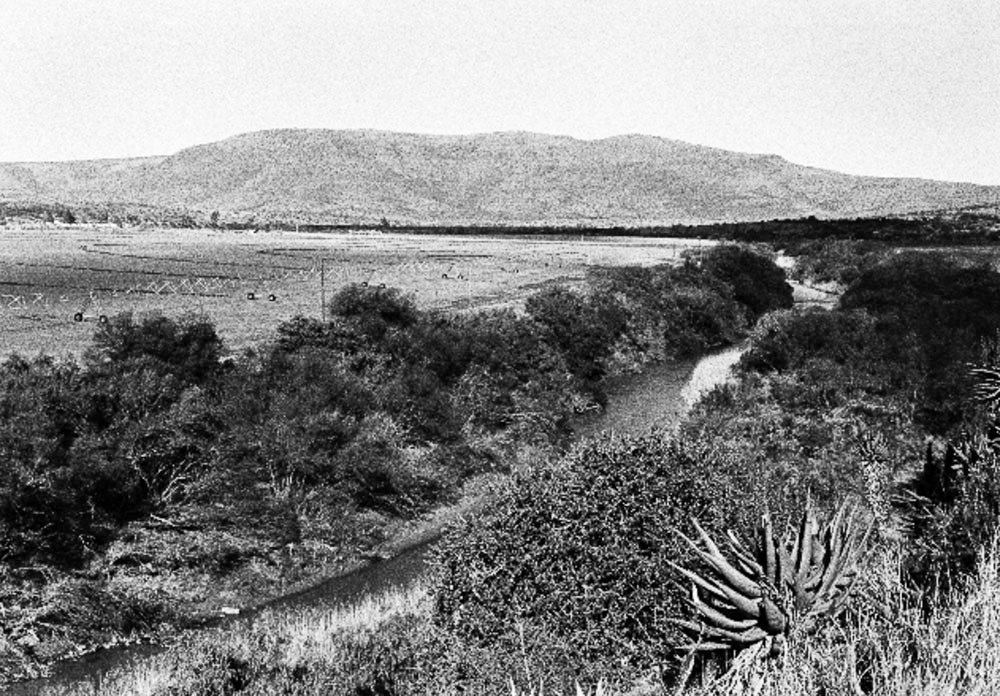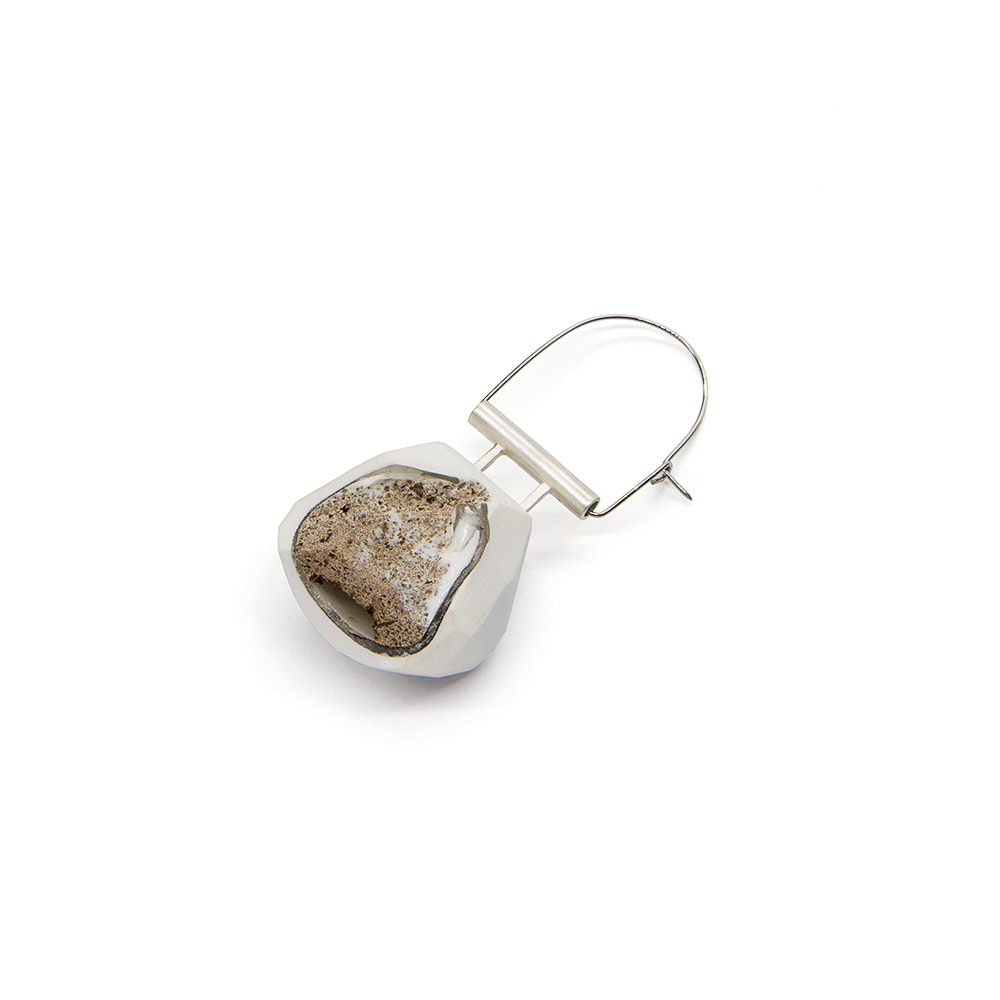Joani Groenewald reflects how her jewellery is drawn from the South African landscape in which she is embedded.
(A message to the reader.)
These landscapes are storage places of memory. Embedded in the nooks and crannies of these rocks, these dongas, these trees, these hills, these rivers, these valleys, these ruins, these monuments, these cities, these cairns… are generations of narratives that continue to haunt the present…. those rivers and those hills recall the chants and the screams that resounded to the heavens when those farmlands were nothing more than theatres of war—villages and fields and grazing lands, all property owned by amaXhosa that had to be defended against colonial encroachment. (Mda 2015: ix)
South Africa is marked by a particularly complex and difficult history that haunts our perceptions of the landscape as it stands today. The mnemonic aspect of landscape is summarised in the above quote by Mda when he references the work of the post-Apartheid South African landscape photographer, Cedric Nunn. Mda points out how memory is embedded in the landscape, and the landscape in turn acts as a “storage place of memory”. Ideas and experiences of brutality, trauma, longing and belonging can be read in the South African landscape, which is largely due to the country’s colonial past. Mda suggests that the photographs taken by Nunn can draw us in and give a glimpse into the history of the landscape.

Cedric Nunn. 2012. The Inxuba River near Somerset East. (Nunn 2014: 11).
I believe that Nunn’s personal and poetic photographic rendition of the landscape gives us insight into the personal and public memories of South African’s Eastern Cape region. His images are, in many ways, a visual translation of his own connection to a given landscape, which gives insight into a shared South African history. Similarly, I believe that photography (as an image-capturing technology) creates a visual artefact that can stimulate a different interaction (in comparison to verbal or written accounts) with that same shared history and landscape. Objects or artefacts prompt interaction and experience, stimulating a tacit knowledge. This is a knowledge that can most often not be explained in (or translated into) words, but one that is primarily experienced through the body’s interaction with a given place or object (Polanyi 1983: 4). As such, I believe that different media and modes of representation can stimulate different perspectives on the interpretation of the South African landscape. In Cherryl Walker’s text Looking Forward, Looking Back: Beyond the Narrative of Loss and Restoration (2010: 24) she asserts the importance of the narration and visualisation of different perspectives of land politics and ownership through art. Walker argues that, as a means to counter the Apartheid and colonial grand narratives, we as (inter alia) artists need to create a more diverse and inclusive account of the South African landscape.
In my own creative jewellery practice, I explore what it means to translate a physical entity, such as a landscape, into a mode or form that is portable and accessible, such as jewellery. Through the creation of these jewellery pieces I explore how the use of materials and their inherent (or structural/tangible) properties can express my own relationship with, and perspective of, a specific landscape (which I will elaborate on later). Jewellery is inevitably entangled in politics of landscape and culture because of its material nature and symbolic function and as such it allows me to explore and express concerns regarding the South African landscape through my creative practice.
A Perspective On The South African Mining Landscape
South Africa has large repositories of mineral resources, such as diamonds, platinum and gold. The discovery and mining of these resources have impacted the way South Africa has developed (especially in socio-economic terms). Cities such as Kimberley and Johannesburg were, for example, founded due to the discovery of their mineral assets. The nature of these minerals that were traditionally included (and still are) in the production of fine jewellery, makes jewellery a good medium to express issues and perspectives on landscape. These minerals demonstrate the complex symbolic function of jewellery, insofar as these materials hint at (amongst other things) South Africa’s colonial history. The latter saw the large-scale exploitation of the South African landscape (its delineation, excavation, commodification and exploitation), which carries with it the burden of the politics surrounding the mining industries in South Africa.
In a piece that I created in 2019 entitled “Karee 3”, I inserted small pieces of platinum and diamond in stone-like forms that formed part of a ring. My aim was to use diamonds and platinum (materials that are mined in the South African landscape) in combination with local soil, with the intention to create a jewellery piece that address concerns regarding the turbulent politics that affect the South African landscape. The materials I used function as the conceptual foundation for this work. The mixture of raw minerals (platinum, diamonds and soil) form the aggregate that, when mixed with cement, water and plastic, creates a strong concrete bond. Through the unconventional application and fusion of these minerals, I wish to question the value and role of each constituent part by showing that, when transformed into the jewellery piece, a complex artefact is created—one that, in some ways, becomes a wearable, remodelled (or unfamiliar) landscape.

Joani Groenewald. Karee 3. 2019. Ring. Silver, Plastic resin, Diamond, Platinum, Cement Soil. 50 x 60 x 18mm
The ring, meant to be worn with the stone-like forms lying in the palm of the hand, poses questions regarding the value of South African mined minerals (in this case there is a specific focus on the use of platinum) in relation to the value ascribed to the lives of mineworkers. The ring refers to a specific incident in South African mining history where mineworkers were protesting due to poor living and working conditions at the Marikana Platinum mine in 2012. During the protests, 34 mineworkers were shot and killed by South African police forces. This tragedy has since become a historical symbol for the politics and violence that surround mining in South Africa.
The piece, entitled “Karee 3”, was named after one of the Marikana mine shafts and the form of the stone-like shapes are derived from maps that I found of the actual Karee 3 mine shaft at Marikana. I used a mixture of plastic and cement to create the stone-like forms. My reason for this was to comment on the artificial value that is often ascribed to natural elements such as diamonds and platinum, questioning their value in the context of the human costs involved in the mining of these materials. For me, the piece functions as a reminder of the tragic incident that occurred at the Marikana mine and the 34 mineworkers who lost their lives in the struggle to improve their own livelihood.
In this piece, I relayed a rather strong political opinion within the context of the South African landscape, whereas in my later work I deal with the politics of landscape in a more nuanced and personal manner.
A personal connection with place
In my latest work, I use my creative practice to draw connections between landscape, memory, language and bodily experience. This forms part of an endeavour to address the urgent need (that Walker also identifies) for a contemporary re-engagement with South African landscape(s). In these works, I reference my own relationship with a farm in the South African region of the Eastern Cape where I grew up in.
My personal association with the Eastern Cape might also be my reason for my connection with the work of Cedric Nunn. Nunn’s landscape photographs are focused on documenting the 100 Year Xhosa war from a contemporary perspective. This war refers to the battle of land between the Afrikaner settlers, British colonisers and Xhosa-speaking communities that resided in the Eastern Cape. His photographs are taken from his own perspective of being Xhosa and his work seeks to uncover a complex history whilst giving recognition to the horrors that were imposed on his forebears at the time of the war (1779-1879). (Nunn 2014: viii). In many ways, Nunn’s work challenges my own connection with the Eastern Cape when he describes the landscape as:
…the land, which was occupied, desired, defended, lost, and won. In it we see its current uses and conditions, both for the victors and the vanquished. We are able to imagine the heroism and mystery of its population as people chose to either defend or attack. We see, too, how little of this memory is commemorated or honoured. We see the smug conquerors and their victims… We see the beauty, which stirred the souls of the inhabitants and the lust of the invaders. (Nun 2014: viii)
When reading this quote by Nunn, my own positionality as a white South African immediately forces me to question my own connection with the farmland where I was raised. This quote stirs up mixed emotions of longing and belonging, ownership and dispossession as the landscape of that farm is deeply embedded in my personal memory, whilst it also forms part of other historical events that were less kind to the humans who dwelled in that landscape and saw it as their own. To an extent, the creation of my jewellery pieces is a response to, or the physical manifestation of, my own conflicting emotions when it comes to the idea of ‘belonging’. In the pieces that I create, I aim to facilitate a critical representation of the South African landscape from a perspective that is sensitive towards the entangled histories and layers of meaning that are present in the landscape.
In order to create my works, I went back to the farmland where I was raised and started a personal process of documentation and excavation. I scavenged and gathered old and discarded objects, twigs, plants, sand, things that looked like they were absorbed by the landscape and things that looked like they were spat out and rejected. Each object had its own idiosyncratic history within and connection to the landscape. By following this process, I was “mining” the landscape (albeit in a different way) for objects of personal significance. The following phase was the process of transformation and re-creation, as I took the found objects and images and started combining them with other materials and turning them into jewellery pieces.

Found Objects from Hasiesfontein-Molteno, Eastern Cape, South Africa. (2019)
Each material that I include in my pieces is chosen both for its individual characteristics (the idiosyncrasies of each material that might appeal to me), as well as the larger cultural associations that each material might carry. These values always work together (and resonate with one another) in the jewellery objects that I create.
For example, I make use of delicate materials such as glass to reference the fragility of my own relationship with the South African landscape and the precarity of my own sense of belonging. Glass is also a material that is made by heating sand to extreme temperatures, thus also carrying with it the imprint of a specific place. To me, the process itself also references the harshness, power and transformation that comes through trauma and disturbance. The use of sand, found objects and plant life makes direct reference to the landscape in question, as I specifically include sand from the farm where I grew up in order to make a direct connection and create a conversation of sorts, with the landscape through my work. The pieces Time capsule, Skipping Stones and Cast in Stone illustrate these concepts through the combination of glass and sand in the works.
- Joani Groenewald. Cast in Sone 1. 2020. Brooch. Silver, Plastic resin, glass, steel wire and Soil. Dimentions (45 x 70 x 20mm)
- Joani Groenewald. Skipping Stones 2. 2019. Pendant. Silver, Glass, Plastic resin, Soil, waxed cotton cord. Dimentions (45 x 40 x 18mm)
In some of my works (see for example the piece entitled Alien-Nation), I also include fragments of Prickly Pear or moulds that were made of the plant. The prickly pear, an imported and invasive plant species, has over centuries become seamlessly integrated with the South African landscape, to such a degree that it seems to belong to native South African flora. Imported from Mexico, it was first planted in the Eastern Cape by settlers, from where it reproduced and spread to other parts of the country. The plant itself later became a source of income for local communities as it was used to make jam and beer (Beinart & Wotshela 2011: 3-5).
For me, this complex sense of belonging also speaks to my own feelings of being in, and longing for the landscape where I was born and grew up in. Furthermore, the use of plastics, moulds and resins potentially talk about the reproduction of ideas and the synthetic attachments, or the imagined relationships, that we forge with places. To me, these materials speak of the myths that we construct around our past, whilst they also reference the scope for manipulation and distortion when it comes to personal memory. The pieces entitled, Time capsule, Skipping Stones, Cast in Stone and Alien Nation reference the way that materials can communicate these concepts in different ways.
- Joani Groenewald. Alien-Nation. 2020. Brooch. Silver, Plastic resin, steel wire and Prickly Pear. 40 x 70 x 15mm
- Joani Groenewald. 2019. Time Capsule. Pendant. Silver, Glass, Plastic resin, Soil and leather cord.
In the piece Time Capsule, I used glass and sand to reference the concepts of the hourglass and the time capsule. Both of these reference time and memory, whilst the latter also references the preservation of ideas. The irregular sizes of the capsule disturb the consistency or stability of the concepts of time, accuracy and preservation, and rather suggests a fluidity (or irregularity) in these concepts.
These pieces demonstrate how the materiality and form of a piece can become its conceptual foundation through its symbolic function and usage.
Conclusion
Jewellery provides a certain intimacy that occurs because of its close placement on the body. It constitutes an artefact that sits on or close to the skin. Moreover, jewellery, unlike most other forms of art, allows for duality in its function and form, as it allows for an internalisation (of ideas, values and memories) through its intimate placement in the body, but also an outward projection of such discursive qualities through its public display. Jewellery thus allows for multiple interpretations; it communicates through its perceived appearance and symbolic function to the viewer, and it functions on an intimate level through a personal connection with the wearer (Maurer-Zilioli 2014: 135). It is this duel function of jewellery that makes it a powerful communication tool, as it invites different perspectives to engage in some form of conceptual or tacit dialogue.
It is this power of jewellery to communicate in a complex way that I find particularly compelling. Through my jewellery practice, I envision my pieces to facilitate some communicative function. I endeavour to create pieces that can function as a trigger to open up conversations with/about the landscape. These are conversations that can carry different perspectives and allow for different interpretations. While the pieces that I create are representations of a personal journey and perspective of the Eastern Cape landscape, they are also created with the intention to prompt conversation, as I believe that conversation has the potential to stimulate much-needed reconciliation, especially when it comes to conflicting histories and narratives concerning the South African landscape.
Further reading
Beinart, W. and Wotshela, L. 2011. Prickly Pear: The Social History of a Plant in the Eastern Cape. Johannesburg: Wits University Press
Maurer-Zilioli, E. 2014. Remembered places – imagined Spaces in Multiple Exposures: Jewellery and Photography. Ilse-Neuman, U. New York: Museum of Arts and Design
Mda, Z. 2015. A Storage Place of Memory. In Unsettled: One Hundred Years War of Resistance by Xhosa Against Boer and British. Brooklyn, New York: Archipelago Books. 139–152.
Nunn, C. 2015. Unsettled: One Hundred Years War of Resistance by Xhosa Against Boer and British. Brooklyn, New York: Archipelago Books.
Polanyi, M. 1983. The Tacit Dimension. Massachusetts: Peter Smith.
Walker, C. 2010. Looking Forward, Looking Back: Beyond the Narrative of Loss and Restoration in The Lie of the Land: Representations of the South African Landscape. M. Godby (ed.). Cape Town: Pinewood Studios. 12–27.
Author
 Joani Groenewald is a South African born jewellery designer, goldsmith and artist. She is a lecturer in the Jewellery Design Division of the Visual Arts Department at Stellenbosch University. Joani views contemporary jewellery as medium through which one can critically reflect upon one’s social and political environment. Currently, she is enrolled for a PhD in Jewellery and Object Design at PXL-MAD Hasselt (Belgium) and Stellenbosch University (South Africa), where she is working under the supervision of Dr. Ernst van der Wal, Dr. Bert Willems and Dr. Karen Wuytens. See website: www.joanigroenewald.com/
Joani Groenewald is a South African born jewellery designer, goldsmith and artist. She is a lecturer in the Jewellery Design Division of the Visual Arts Department at Stellenbosch University. Joani views contemporary jewellery as medium through which one can critically reflect upon one’s social and political environment. Currently, she is enrolled for a PhD in Jewellery and Object Design at PXL-MAD Hasselt (Belgium) and Stellenbosch University (South Africa), where she is working under the supervision of Dr. Ernst van der Wal, Dr. Bert Willems and Dr. Karen Wuytens. See website: www.joanigroenewald.com/
Acknowledgements:
I would like to give special thanks to Dr Ernst van der Wal for his contribution towards formulating some of the ideas presented in this article. Without his mentorship, friendship and continuous support this article would not have been written.






Comments
Your works are beautiful, more grace. Warm regards.